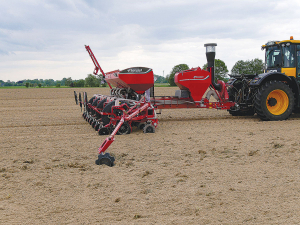Kverneland to debut Alentix fertiliser spreaders at Agritechnica
With Agritechnica just around the corner, it’s no surprise to see manufacturers drip-feed some information of new products worth a closer look.
 The latest 6-metre trailed Optima TF Profi combines the conventional SX seeder system, with a central seed hopper over the seeding unit.
The latest 6-metre trailed Optima TF Profi combines the conventional SX seeder system, with a central seed hopper over the seeding unit.
The Kverneland Optima precision drills are well known and respected for high levels of accuracy and performance.
The recent addition of the SX pressurised seeding unit addresses increasing workloads or shorter timeframes. It can operate at speeds of up to 18km/h, while still maintaining the pinpoint accuracy and reliability that professional users have come to expect.
The latest 6-metre trailed Optima TF Profi combines the benefits of the SX seeder system with an alternative to the conventional format of individual seed hoppers over the seeding unit. It uses a central seed hopper with an 870-litre capacity.
The machine is designed to increase daily outputs, with the large single hopper offering an extra 390 litres capacity over eight, 60 litre single hoppers. It uses a highspeed delivery airstream, generated by the standard fan, to the individual seeding units.
The hopper is configured with an outlet for each of the rows, with seeds transported via the airstream to individual 1.5-litre capacity intermediate hoppers. These act as a buffer at each precision unit. If, for any reason, the buffer hopper is full, seed delivery is suspended, then re-engages as the level drops.
At the SX seeding unit, air is used for delivery, with a layout featuring an upper scraper assembly for seed singulation and a lower scraper controlling the alignment of larger seeds. Once “selected”, seeds drop into an airstream for positive placement, with seed-to-soil contact achieved by large diameter V-shaped press wheels.
Throughout the process, an infra-red photo sensor monitors seed positioning and indicates any “doubles”, while also offering information on hopper levels and any coulter blockages.
Utilising Kverneland’s patented e-drive system, each row is powered by the ISOBUS control system. This removes the need for the additional PTO-driven generators – typically seen on competitive machines.
Additionally, the layout of the e-drive system sees a shaft and gear drive acting directly on the singulation disc. This means there is a near elimination of moving parts within the unit, resulting in reduced friction or wear and a minimised power requirement.
As part of the package, GPS and Geo Control – via the Kverneland Tellus Monitor – is used in conjunction with the Optima e-drive system to automatically switch seed delivery on and off. This helps to ensure headland accuracy and remove overlaps in short ground or irregular headlands – thus saving on seed costs, while also maintaining accuracy in dusty, poor light or night-time operations.
Aimed at getting crops off to a rapid start, the TF Profi is also equipped with a 2,000-litre fertiliser hopper. Again, it is controlled from the ISOBUS system and driven hydraulically from the tractor. Integrated weigh cells work in conjunction with the Tellus/ GPS componentry to apply pre-determined rates, control auto shutoff at boundaries and section control – while also helping with accurate calibration.
Like the seeding componentry, an air delivery system deposits fertiliser adjacent to the seed, via its own double-disc coulter configuration.
Kverneland machinery is imported and distributed in NZ by the Power Farming Group.
Federated Farmers says almost 2000 farmers have signed a petition launched this month to urge the Government to step in and provide certainty while the badly broken resource consent system is fixed.
Zespri’s counter-seasonal Zespri Global Supply (ZGS) programme is underway with approximately 33 million trays, or 118,800 tonnes, expected this year from orchards throughout France, Italy, Greece, Korea, and Japan.
Animal owners can help protect life-saving antibiotics from resistant bacteria by keeping their animals healthy, says the New Zealand Veterinary Association.
According to analysis by the Meat Industry Association (MIA), New Zealand red meat exports reached $827 million in October, a 27% increase on the same period last year.
The black and white coat of Holstein- Friesian cows is globally recognised as a symbol of dairy farming and a defining trait of domestic cattle. But until recently, scientists didn’t know which genes were responsible for the Holstein’s spots.
According to the New Zealand Dairy Statistics 2024/25 report, New Zealand dairy farmers are achieving more with fewer cows.